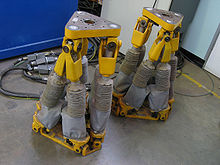Stewart platform: Difference between revisions
No edit summary |
→External links: vid copied from German wiki :> |
||
| Line 50: | Line 50: | ||
==External links== |
==External links== |
||
<!--No advertising allowed!--> |
<!--No advertising allowed!--> |
||
*[http://de.youtube.com/watch?v=kS9oxp0mlw8 Highspeed hexapod Mill demonstration (Video 3:46)] |
|||
*[http://www.hexapods.net/] |
*[http://www.hexapods.net/] |
||
*[http://www.symetrie.fr/en/ SYMETRIE positioning hexapod] |
*[http://www.symetrie.fr/en/ SYMETRIE positioning hexapod] |
||
Revision as of 00:50, 15 May 2010



A Stewart platform is a kind of parallel manipulator using an octahedral assembly of struts. A Stewart platform has six degrees of freedom (x, y, z, pitch, roll, & yaw).
Development
The Stewart platform was first reported in a paper by V. E. Gough in 1956. The name of Stewart was attached to this architecture because Gough's earlier work (and a photograph of his platform) were mentioned in the reviewers' remarks to a paper by D. Stewart published in 1965; in that paper, Stewart presents another hybrid design, with three legs having two motors each.
Dynamics of the Stewart platform
There are six independently actuated legs, where the lengths of the legs are changed to position and orient the platform. The forward kinematics problem, a system of equations which given the leg lengths, yields the position and orientation of the platform, has up to 40 solutions. However, the inverse kinematics problem (i.e. given the position and orientation of the platform, find the required leg lengths) has a unique and very simple solution.

Applications
Stewart platforms have applications in machine tool technology, crane technology, underwater research, air-to-sea rescue, flight simulation, satellite dish positioning, telescopes and orthopedic surgery.
LIDS
The Low impact docking system developed by NASA uses a Stewart platform to manipulate space vehicles during the docking process.
Hexapod
Geodetic Technology trademarked "hexapod" for a Stewart platform in a machine tool context. However, apparently this has not stopped other machine tool manufacturers from using the term. The open source CNC software package, the Enhanced Machine Controller (EMC) [1] is capable of driving a Stewart platform using standard G-codes such as used for milling machines, etc.
RoboCrane
James S. Albus of the National Institute of Standards and Technology (NIST) has developed a crane, known as RoboCrane, which uses the Stewart platform technology.
Taylor Spatial Frame
Dr. Charles Taylor utilized the Stewart platform to develop the Taylor Spatial Frame [2], an external fixator used in orthopedic surgery for the correction of bone deformities and treatment of complex fractures.
Tyre testing
Eric Gough was an automotive engineer and worked at the Dunlop Tyres factory in Birmingam, England. He developed his "Universal Tyre-Testing Machine" (also called the universal rig) in the 1950s and his platform was operational by 1954. The rig was able to mechanically test tyres under combined loads. Gough died in 1972 but his testing rig continued to be used up until the late 1980s when the factory was closed down and then demolished. His rig was saved and transported to the Science Museum (London) storage facility at Wroughton near Swindon.
See also
References
- D. Stewart, "A Platform with Six Degrees of Freedom", UK Institution of Mechanical Engineers Proceedings 1965-66, Vol 180, Pt 1, No 15.
- Gough, V. E., Contribution to discussion of papers on research in Automobile Stability, Control and Tyre performance, Proc. Auto Div. Inst. Mech. Eng., pages 392-394, 1956-1957.
- Bonev, I.A., "The True Origins of Parallel Robots", ParalleMIC online review
External links
- Highspeed hexapod Mill demonstration (Video 3:46)
- [3]
- SYMETRIE positioning hexapod
- Pictures of the NIST/Ingersoll prototype octahedral hexapod
- Hexapod Structures for Surgery
- LME Hexapod Machine
- Hexapod for Astronomy
- 'Hexapod in MAX-lab High-Energy Physics Research'
- Fraunhofer Research: Hexapod Robot for Spine Surgery
